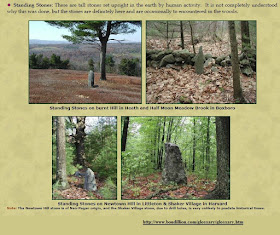Don’t get me
wrong. There are spectacular Stone Ceremonial Landscape sites in remote
locations all over Turtle Island. But as Diane Dix says, “(T)he lithic remains
of the Native Americans of New England remained hidden in plain view for
centuries. Many of these features are
constructed with stone and blend quietly and reverently into the natural
surroundings. Yet, once one awakens to their presence they seem to be
everywhere.”
And I agree with
Diane, these stone features seem to be everywhere, especially once you begin to
see the repeated shapes and patterns – and all the variations – everywhere you
go. Especially when traveling along New England roads where the older
Indigenous Stonework remains relatively undisturbed. I pass by openings in
stone walls and suddenly notice wonderful examples of big triangular boulders often
on both sides of the entryway that once you look more closely resemble
Rattlesnake heads. (Such as these https://wakinguponturtleisland.blogspot.com/2015/01/another-possible-ophiomorphic-petroform.html or any of these for that matter https://wakinguponturtleisland.blogspot.com/search?q=gateway)
Just lately, I’ve
been looking at other people’s photos on social media noting all the different forms
of Manitou Stones, from seeming simple triangles to those “head and shoulders”
types as well as everything else in between. I’m not sure who named these
stones Manitou Stones and can only vaguely tell you what it symbolizes or
means, much like I can only vaguely tell you that Manitou is a kind of an essence
of life and spirit contained in everything from stars to stones to animals and
people and, well, everything.
So I went looking
at posts from this past April (2017) to find some Manitou Stones I just
happened to observe while looking to see if a row of stones behind a local
hardware store (I was looking out the window by the paint mixer machine at a “stone
wall”), not exactly a remote location but still sort of one considering that
not too long ago there were more cows than people populating this particular
Connecticut town.
Above: Main Street South
Below: The window circled in red and the approximate location of the "Stone Wall"
I tried looking at some old 1934 aerial photos to see if the stones showed in that:
I fooled around a while and tried some tricks with Google Earth, looking for the houses that would put things into perspective (putting north at the top too). That's the row of stones circled in yellow:
So here's the beginning of the row, disturbed a bit at the western end:
Following the row:
Noting some small possible Manitou Stones and observing the stack, somewhat reminiscent of certain stone piling in stone mounds:
And the end stone:
Adding the eye:
So I turned a little north and west, pondering the boulders I could make out thru the trees:
Closer, photo-bombed by a red dog for perspective:
I couldn't help but notice the sort of rhomboidal shape within the Manitou - and as I looked up there's that sort of sugar loaf shape again in another couple boulders:
It was an eye-opening experience:





















































